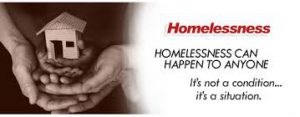
It's a rainy Monday morning. Joy thought of a new workshop over the weekend to get more men to work . It's all about positioning the usual to a higher level of industry.
What a day to run late--and it's raining, too. Mondays, Joy has workshops at 9 o'clock. It's 8:45 AM and she's still jogging down the street, less than a block away from the shelter.
Now signed in at the gate, Joy greets her office mates as she walks to her desk. She's happy that she doesn't have to rush the Captain of Security off the PC that they share. She assembles her handouts, the attendance sheet, the scrap paper, and pencils to place them on top of the roll-around cart. This cart carries the laptop and speakers she uses to show videos from her favorite employment and education websites. She reaches for the pole she uses to pull down the screen in the rec area and remembers to put a rubber band around her wrist. The rubber band is used to keep the power plug in the wall socket.
Pulling the cart out of the room, she glances at Helen who is busy with a resident who is submitting a transit authorization form to get MetroCards. As she walks down the hall to the rec area, she greets the amiable security officer with well-kept locks, then turns into the huge room to set up for the workshop called "How to Make a Job". The workshop may seem obvious but it is all about kick-starting the men she sees day after day in the building. They are a "resistant" body to the cause for self-sufficiency.
Of the 182 - 200 clients in the shelter, she recognizes the faces of 30 to 40 men who are regular features of the room. They have their particular sitting locations and people with whom they associate. One man sits close to the door from where security officers are posted, behind a table he pulls from the cafeteria area. He is a stark example of "watching your back". There's a duo of "tailors" in a corner. One is an older Japanese man who still speaks with a thick accent. The other is a much younger African American man. The older man repairs the clothes of other clients and employees with his sewing machine. The younger man tends to sew swatches of cloth onto to skullcaps, jeans, and jackets. Joy finds out later these men get paid for their services. She's never seen cash exchanged but that's the word in the building. "How to Make a Job" workshop is inspired by this industry.

Joy goes around the entire room inviting men to come over to the workshop. She writes down names, bed numbers, work interests, occupational needs, and notes refusals. The clients are required to participate in the workshops unless they are seniors or have medical documentation indicating they can't work. Although they know this, people will refuse or say they have an appointment that's coming up soon. Why don't they know not to be in the rec area during scheduled workshops? Joy will have to follow a refusal with the completion of a Client Interaction Update that is sent to his Case Manager.
So how do you make a job? Here's a short list:
1) If you don't have welfare payments to finance things, get a plastic garbage bag from a custodian to hold the bottles and cans you will collect. 200 bottles/cans earns you $10. The earlier in the morning you go out to collect, the quicker you'll gather and redeem them. With that $10, you can buy the equipment you need for odd jobs: sponges, brooms, dust pans, sewing needles (may be prohibited by shelter), thread, shovels, etc. Collect as many times as you need to purchase your supplies.
2) Get a piece of 8 x 11 paper and a pen or pencil from the Social Services department. Fold the paper such that you have 16 boxes. Neatly write "Handy Man", your name, and cellphone in each box. Return to Social Services to have several copies of this paper run off. Save the original for future copying. The copies should be carefully torn into 16 pieces. These are your business cards.
3) With your tools, knock on doors of homes and ask to pull weeds, rake leaves, sweep their stoop, walkways, and the sidewalk to the curb. Tell your prospective client you charge $15 for the service. This job is needed April though November. The same approach can be used for snow shoveling in the winter; cleaning display windows & sweeping sidewalks for businesses; washing dishes for restaurants, cleaning outside of private child care centers or sewing for local dry cleaners and tailors.
4) Leave your card with everyone you talk to. Say something pleasant so you leave a pleasant impression. Knock on each door on each side of a street. The goal is get your first 10 customers. With ten regulars, you'll earn at least $150 per week, if you only service them once per week. Make sure you have paper and a pen or pencil to write down your new customers' name and address. Remember not to stop at 10, keep walking to different streets to pitch for work.





